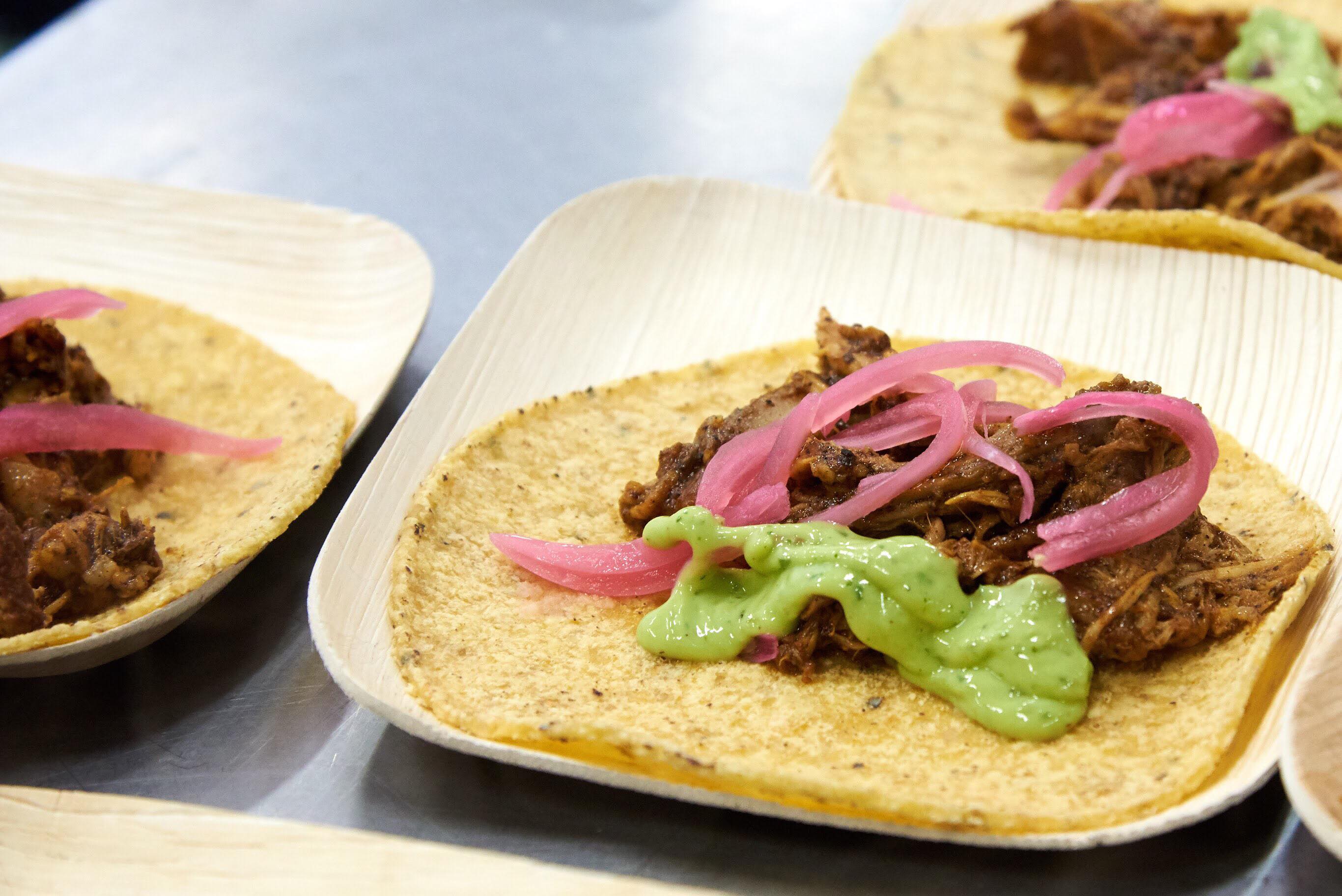When Andi Murphy, an Albuquerque-based journalist and associate producer at Native America Calling, realized the expansiveness of the Native food movement, she began passionately pitching story after story on Indigenous cuisine at her weekly editorial meetings. That is, until her editor put a cap on the amount of food content she could pitch. That’s when, at the suggestion of a co-worker, she decided to start Toasted Sister – a podcast exploring and highlighting the work of Indigenous chefs in the Americas.
Murphy didn’t grow up having a close connection to the cuisine of her Indigenous heritage, despite growing up on the eastern side of the Navajo Nation in New Mexico. The loss of ancestral knowledge was partly a result of governmental systems of assimilation, which included the Native American boarding school system of the 1900s that forced Native children to embrace Euro-centric teachings. “They forbade kids from learning their language and culture, and that’s a system a lot of my ancestors come from. So that means a lot of those recipes and a lot of that food knowledge never trickled down to me,” she tells me. Besides a few dishes like mutton stew and fry bread, the food cooked at home was removed from traditional cultural cuisines.
“They forbade kids from learning their language and culture, and that’s a system a lot of my ancestors come from.”
During college and later as a reporter in Las Cruces, New Mexico, she developed an interest in food. But it wasn’t until she started working at Native America Calling that she began exploring Indigenous foodways.
Murphy created the podcast as a way to give a platform to a wide-ranging and diverse Native food movement that often gets misrepresented or labeled as a trend, despite its ancient existence. During the development of Toasted Sister, she didn’t hesitate to include Indigenous chefs with roots in Latin America.
The Indigenous diaspora from Latin America is heavily concentrated in the United States due to income inequalities and violence that often disproportionately affects Native communities and forces them to flee. Los Angeles, for example, boasts the largest number of Zapotec people outside of Oaxaca, as well as a sizable Maya community who fled Guatemala during the civil war. Because these immigrants often end up working within the food industry as farmworkers, cooks, and owners of restaurants and food stands, Indigenous peoples of Latin America have a great influence in modern American food system. And often the influence has deep similarities to the food cultures of Native communities in present-day North America.
“Just because there’s a border there doesn’t mean anything at all. They’re doing the same thing we are doing. It’s the same movement but with different ingredients and cultures,” Murphy explains. It makes sense considering the imaginary lines that exist today are due to colonization, and therefore relatively new.
Toasted Sister’s guests include Mixteco, Lenape, Lakota, Diné, Tewa, Ute, Purépecha, and Andean chefs, among many others. Despite a great cultural diversity in the subjects featured, there are shared historical experiences and values.
“The similar goals are to really put the flavors up front and show that Native food is not just a taco, it’s not just a fry bread. [The chefs] want to show that there’s multiple layers of flavor here. And they also want to show that we also have these struggles too and this sometimes terrible history behind it.” Murphy describes. “With everyone, there’s the common topics of decolonization, traditional food and knowledge, food for health, sustainability, respecting the land and the food, knowing where the food comes from. Being a minority. But everyone has a particular insight and particular views.”

In one episode, Neftali Duran, a Mixteco chef originally from Oaxaca, discusses the importance of the often Indigenous migrant workers to our food system. “A lot of the things that make American food exciting is Indigenous technology,” he says in the episode, referring to food items like tacos and tortillas. “They are the results of Indigenous peoples improving and inventing new technologies for thousands of years.”
In another episode, featuring Claudia Serrato – a chef and professor from East LA with roots in central Mexico’s Indigenous Purépecha community – the podcast highlights the cross-pollination of culinary influence among Native peoples, regardless of borders. Serrato describes the importance of using local Indigenous ingredients in her decolonial pop-up dinners but also finds the beauty in sharing Indigenous ingredients across Native communities through modern and ancient trade routes, which she likens to an “Indigenous fusion.” Serrato describes the journey of corn and amaranth as an example of food stuffs that have made their way throughout present-day North, South, and Central America.
Andrea Murdoch, an Andean chef based in Denver, further drives the point of this shared culinary influence in an episode where she discusses the inspiration behind her dishes, which include ingredients such as quinoa from South America and wild rice from the Midwest. “I like bridging the gap between North American and South American indigenous food…sort of bring these cultures together in a plate of food, it’s almost poetic in a way to blend these different things together,” Murdoch explains in the episode.
Using decolonized cuisine – dishes that use ingredients native to the land that were not brought by colonization – as a way to address health disparities is a topic many of the chefs featured in the podcast often touch on. “We probably know two or three people in our community who have died of heart disease or diabetes and that’s directly related to the food that we are eating. A lot of these chefs want to turn that around and talk about connecting to our ancestral foods. I love when they talk about, ‘We have this in our DNA. We’ve been cooking this food for thousands of years, and it’s our medicine, it was made for us, and when we don’t have that, when we have these Western foods full of fat and sugar,’’’ Murphy says.
The podcast is a way to give the chefs a place to delve into shared issues that move far deeper than the flavors of the dish while also celebrating the edible and cultural diversity of each region. For Murphy, it’s been a way to gain a deeper appreciation for Native foods and regain a lost connection to the food of her ancestors. “Food has become precious. It’s given me a greater appreciation for foods that come from the Navajo nation and made me a lot more curious with some of the connections I could make with my elders,” she explains.
“It is important to highlight these Indigenous foodways because it’s still there, because we are still here.”
In using her resources and expertise to highlight Native foodways, she helps fill the void for accurate and culturally appropriate representation that provides a way for people to regain some of that lost knowledge. “That’s me doing my part to make sure that that what these chefs are doing is going to be seen by other people, especially by other people who are kind of like me, who don’t know as much, who are not that connected but can learn from this podcast and learn from these chefs,” Murphy explains.
Most importantly, she’s ensuring this information isn’t lost and that the culinary culture isn’t further erased. “I meet people who are like, ‘I’m the only speaker in the village.’ It’s the same way with food. If you don’t learn these things they’re going to disappear and these roots and plants are just going to be weeds to you and you won’t know how valuable they were to your ancestors and how valuable they can be to you,” Murphy says.
Through her platform, Murphy creates a space for Native food workers to represent themselves and show that Indigenous culture isn’t something of the past. She adds, “It is important to highlight these Indigenous foodways because it’s still there, because we are still here.”
April 12, 5:55 p.m. ET: This story has been update to change Andrea Murdoch’s location from Milwaukee, where she used to reside, to Denver, where she now lives.







